Dec 17, 2008
Pre-industrial CO2 Levels Were About the Same as Today. How and Why We are Told Otherwise?
By Dr.Tim Ball, Canada Free Press
How many failed predictions, discredited assumptions and evidence of incorrect data are required before an idea loses credibility? CO2 is not causing warming or climate change. It is not a toxic substance or a pollutant. Despite this President Elect Obama met with Al Gore on December 9 no doubt to plan a climate change strategy based on these problems. They make any plan to reduce of CO2 completely unnecessary.
Proponents of human induced warming and climate change told us that an increase in CO2 precedes and causes temperature increases. They were wrong. They told us the late 20th century was the warmest on record. They were wrong. They told us, using the infamous “hockey stick” graph, the Medieval Warm Period (MWP) did not exist. They were wrong. They told us global temperatures would increase through 2008 as CO2 increased. They were wrong. They told us Arctic ice would continue to decrease in area through 2008. They were wrong. They told us October 2008 was the second warmest on record. They were wrong. They told us 1998 was the warmest year on record in the US. They were wrong it was 1934. They told us current atmospheric levels of CO2 are the highest on record. They are wrong. They told us pre-industrial atmospheric levels of CO2 were approximately 100 parts per million (ppm) lower than the present 385 ppm. They are wrong. This last is critical because the claim is basic to the argument that humans are causing warming and climate change by increasing the levels of atmospheric CO2 and have throughout the Industrial era. In fact, pre-industrial CO2 levels were about the same as today, but how did they conclude they were lower?
In a paper submitted to the Hearing before the US Senate Committee on Commerce, Science, and Transportation Professor Zbigniew Jaworowski explains, “The basis of most of the IPCC conclusions on anthropogenic causes and on projections of climatic change is the assumption of low level of CO2 in the pre-industrial atmosphere. This assumption, based on glaciological studies, is false.”
Ice cores provide the historic record and data collected at Mauna Loa the recent record. Both records are drastically modified to produce a smooth continuous curve with little variability. This was necessary to confirm the evidence falsely concluded from many 19th century measures that pre-industrial levels were approximately 280 ppm and didnít vary much. So how did they engineer the smooth curves and ignore the fact the 19th century record shows a global average of 335 ppm and considerable variability from year to year.
Most people don’t know that thousands of direct measures of atmospheric CO2 were made beginning in 1812. Scientists took the readings with calibrated instruments and precise measurements as the work of Ernst-Georg Beck has thoroughly documented. Guy Stewart Callendar was an earlier visitor to these records. He rejected most of the records including 69% of the 19th century records and only selected certain records that established the pre-industrial level as 280 ppm. Here is a plot of the records with those Callendar selections circled:
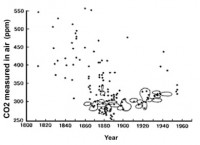
It is clear how only low readings were chosen. Also notice how the slope and trend is changed compared to the entire record. As Jaworowski notes,
“The notion of low pre-industrial CO2 atmospheric level, based on such poor knowledge, became a widely accepted Holy Grail of climate warming models. The modelers ignored the evidence from direct measurements of CO2 in atmospheric air indicating that in 19th century its average concentration was 335 ppmv.” Beck recently confirmed Jaworowski’s research. A September 2008 article in Energy and Environment examined the readings in great detail and validated the 19th century findings.
Modern greenhouse hypothesis is based on the work of G.S. Callendar and C.D. Keeling, following S. Arrhenius, as latterly popularized by the IPCC. Review of available literature raise the question if these authors have systematically discarded a large number of valid technical papers and older atmospheric CO2 determinations because they did not fit their hypothesis? Obviously they use only a few carefully selected values from the older literature, invariably choosing results that are consistent with the hypothesis of an induced rise of CO2 in air caused by the burning of fossil fuel. Read more here.
Dec 16, 2008
NASA Models Can’t Get Simpler Mars Climate Right
By Irene Klotz, Reuters
NASA is still unable to say for sure whether its Phoenix lander has found a place where life could have existed on Mars.

But scientists working with the U.S. space agency said on Monday computer models they have been using to predict what the weather would be like on the Red Planet are wrong, and more accurate models would give a better picture of its past.
Speaking at the opening day of the American Geophysical Union conference in San Francisco, Phoenix mission scientists laid out the early harvest from five months of robotic operations on the northern polar region of Mars.
In addition to analyzing ice and soil samples for organic material, a process that is still under way, the Phoenix science team collected daily weather reports, information considered critical to learning if the planet could have supported water long enough for life to evolve. “It’s a very active weather environment,” lead investigator Peter Smith told reporters in a teleconference. “It’s a bit of a mystery how this is happening.”
Phoenix saw dusty summer days slip into cloudy fall, replete with ground fog, snow and frost. “Global climate models that are running on Mars would not predict this,” Smith said. “What we’re learning now about the polar region is going to force us to make changes.”
More accurate computer models would give scientists a clearer picture of what happened in Mars’ past, particularly when the planet’s axial tilt, or obliquity, was greater than it is now.
Without a large moon for stabilization, Mars’ polar regions periodically shift off axis by more than 35 degrees. During those times, the sun would rise higher in the sky above the Martian poles, making for warmer summers.
Scientists are trying to determine if there was ever a period of time when it would have been warm enough for water, considered a key ingredient for life as we know it.
“We’re really trying to understand if this was ever a wetter environment,” Smith said.
“If we can update these global circulation models and we can understand better about the polar weather, then we can look back in time to see if liquid water was ever a dominant influence on this soil in this location.”
Read more here.
Dec 16, 2008
Defying Predictions, Sea Level Rise Begins to Slow
By Michael Asher, Daily Tech
World’s oceans rise slower since 2005, fail to display predicted accelerating trend. Satellite altimetry data indicates that the rate at which the world’s oceans are rising has slowed significantly since 2005. Before the decrease, sea level had been rising by more than 3mm/year, which corresponds to an increase of about one foot per century. Since 2005, however, the rate has been closer to 2mm/year.
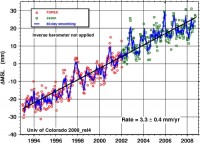
Source: University of Colorado, Boulder
The decrease is significant as global climate models predict sea level rise to accelerate as atmospheric CO2 continues to increase. In the 1990s, when such acceleration appeared to be occurring, some scientists pointed to it as confirmation the models were operating correctly. Sea level rise was calculated from altimetry data from the TOPEX/Poseidon and Jason-1 satellite missions, published by the University of Colorado, Boulder.
Dr. James Choe, a research associate with the University of Colorado, says the decrease is temporary. “Interannual variations often cause the rate to rise or fall”, he says. Choe believes an accelerating trend will reappear within the next few years. Oceanographer Gary Mitchum of the University of South Florida, says making any judgement from the limited data available is “statistically so uncertain as to be meaningless”.
Others disagree. Dr. Vincent Gray, a New Zealand based climatologist and expert reviewer for the IPCC, believes that the accelerated trends seen earlier were simply an artifact of poor measurements. “The satellite system has undoubtedly shown a rise since 1992, but it has leveled off”, he tells DailyTech. “They had some bad calibration errors at the beginning.” Gray points to a study done by Flanders University using tide gauges which, he says, measured no perceptible increase in sea level over its entire 15 year period.
Sea level has been rising since the end of the last ice age, some 20,000 years ago. During an episode known as “Meltwater Pulse 1A”, the world’s oceans rose by more than 5 meters per century, a rate about 20 times faster than the current increase. TOPEX/Poseidon was launched by NASA in 1992, and collected data until 2005. In 2001, NASA and France’s Centre National d’…tudes Spatiales (CNES) launched its follow-up mission, Jason-1. Jason-2 was launched in June of this year. Read more here.
Dec 14, 2008
Global Warming is Caused by Computers
Climate Skeptic
In particular, a few computers at NASA’s Goddard Institute seem to be having a disproportionate effect on global warming. Anthony Watts takes a cut at an analysis I have tried myself several times, comparing raw USHCN temperature data to the final adjusted values delivered from that data by the NASA computers. My attempt at this compared the USHCN adjusted to raw for the entire US:
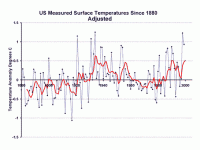
See animation before and after adjustment here.
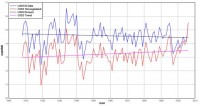
See larger image here.
Anthony Watts does this analysis from USHCN raw all the way through to the GISS adjusted number (the USHCN adjusts the number, and then the GISS adds their own adjustments on top of these adjustments). The result: 100%+ of the 20th century global warming signal comes from the adjustments. There is actually a cooling signal in the raw data:
Now, I really, really don’t want to be misinterpreted on this, so a few notes are necessary:
Many of the adjustments are quite necessary, such as time of observation adjustments, adjustments for changing equipment, and adjustments for changing site locations and/or urbanization. However, all of these adjustments are educated guesses. Some, like the time of observation adjustment, probably are decent guesses. Some, like site location adjustments, are terrible (as demonstrated at surfacestations.org).
The point is that finding a temperature change signal over time with current technologies is a measurement subject to a lot of noise. We are looking for a signal on the order of magnitude of 0.5C where adjustments to individual raw instrument values might be 2-3C. It is a very low signal-noise environment, and one that is inherently subject to biases (researches who expect to find a lot of warming will, not surprisingly, adjust a lot of measurements higher).
Warming has occurred in the 20th century. The exact number is unclear, but we have much better data via satellites now that have shown a warming trend since 1979, though that trend is lower than the one that results from surface temperature measurements with all these discretionary adjustments. See full post here.
Dec 12, 2008
Record Early Snow in New Orleans and Houston
By The Times-Picayune
New Orleans Metro area residents woke up to falling snow on Thursday, December 11, 2008. Snow in New Orleans is a rarity. The last time it snowed was Christmas 2004; before that, the last snow recorded was in 1989, according to Jim Vasilj, a forecaster with the National Weather Service. Since 1850, snow had fallen in “measurable amounts” rather than traces in the city just 17 times, Vasilj said. Of the 17, today’s snowfall was the earliest in the season recorded. As much as 6 inches had piled up in Livingston Parish as of 10 a.m., Vasilj said. Similar amounts were reported in Bogalusa and St. Helena Parish, while in Mandeville, between 2 and 3 inches had accumulated, according to Vasilj.
For the first time in nearly four years, snow fell across the New Orleans region this morning, with flurries reported on the north shore and in the city, Metairie, Kenner, LaPlace and other parts of the south shore. By around 10 a.m., the snow had mostly stopped, replaced by freezing rain in many places, making driving treacherous. By noon, the precipitation had mostly ceased altogether.

By mid-morning, enough snow had accumulated on the ground in some areas to lure children and adults onto their front lawns to build snowmen or have snowball fights. In the city, neutral grounds remained blanketed in white, though the streets generally remained clear as the wet stuff melted upon hitting the pavement. In Mandeville, where the snow was heavier, lawns were covered with thicker blankets of white fluff as school buses filled with squealing students made the rounds. Children, most seeing snow for the first time Christmas Day 2004, tried to catch flakes in their hands as the buses rumbled along.

While snow in the Deep South is a pleasant novelty, the weather did cause trouble for some. A handful of schools and universities shut down for the day, bus service was disrupted, and flights at Armstrong International were cancelled or delayed. Outages were also reported in St. Tammany and Washington parishes, with the majority in the Franklinton area, according to Cleco spokeswoman Robbyn Cooper. Cleo has a total of nearly 7,000 power outages statewide, most of them in Allen, Evangeline, Acadia and St. Landry parishes. Read more here. Last night Houston too had the earliest snow on record. See also this official NWS summary of the snowfall in the New Orleans area last week. And courtesy of our friends at the METSUL who found this New Orleans Gore Snowman.
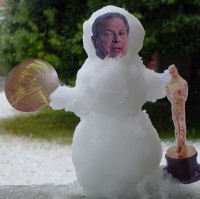
|










